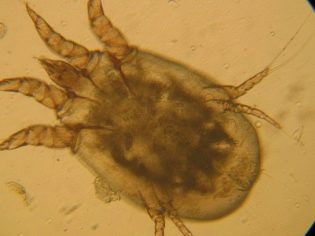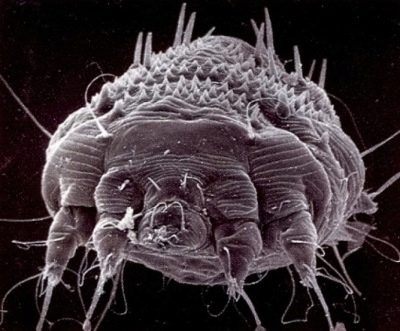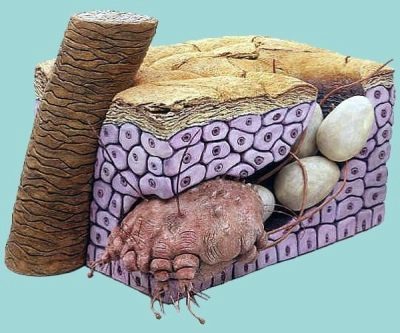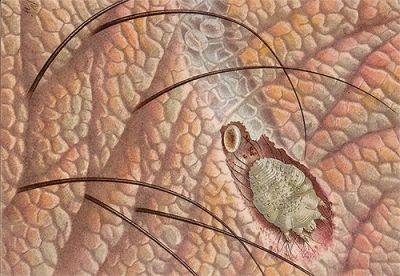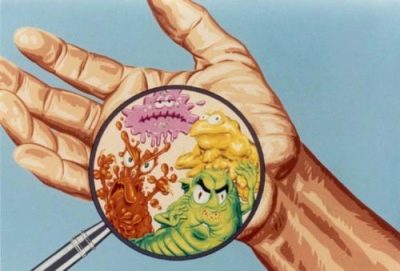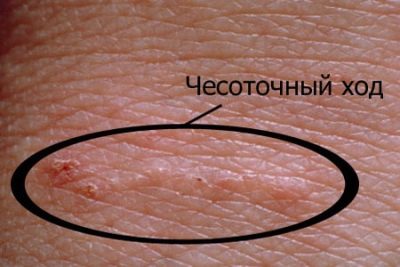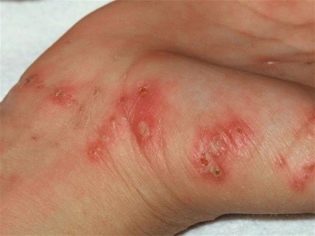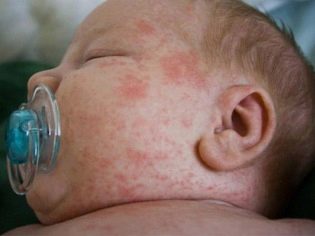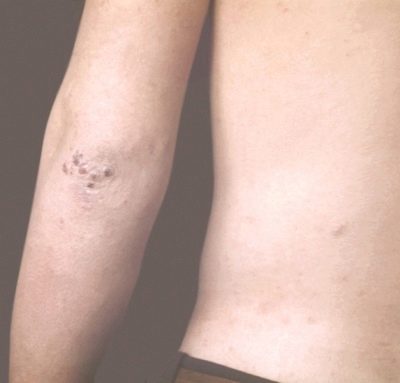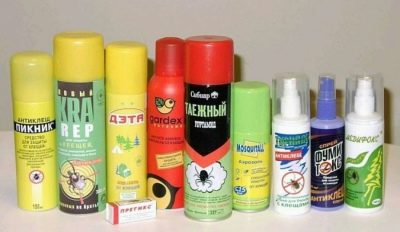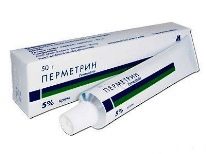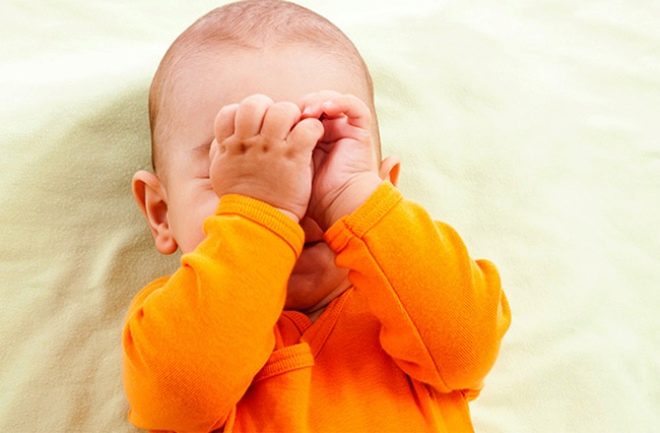Symptoms and treatment of scabies in children
Scabies in a child is a contagious dermatological disease that delivers a lot of discomfort. About where it comes from and how to treat it, we will explain in this article.
About the disease
Scabies is known to mankind since the days of the Old Testament, it was there that it was described for the first time. For quite a long time, people considered the unbearable itchiness that “attacked” at night was a heavenly punishment. But in the Middle Ages, doctors began to guess that the reason for the terrible situation was the parasite. The mite was found only when the microscope was opened. In the 17th century, doctors managed not only to examine in detail the petty “culprit” of an unpleasant disease, but also to describe scabies, and also to propose the first official measures to combat it.
Itchy pruritus (this is the name of the tick that causes the disease), makes the disease extremely contagious, as it takes only 15-20 minutes to penetrate a person’s skin and begin to parasitize under it. Outbreaks of scabies are most often recorded in Russia in the fall and winter. And to a greater extent, it is not kids who, as it may seem, even teenagers have this skin disease. Scabies are rarely detected in newborns only if they are sick of their parents or those who care for the baby.
On average, medical statistics say that 5-6% of the world's population has had scabies at least once in their lives. Senior pupils and teenagers account for about a quarter of all cases. The official name of the disease is scabies. The more common name "scab" fully reflects the main and most painful symptom of the disease - the skin under which the itch settles is unbearably itchy.
In the first place in terms of the number of diseases, it is teenagers. On the second - junior and middle schoolchildren. Kids of preschool age - only on the third.
About the pathogen
The mite is small. The largest females reach a length of half a millimeter, and the males are half as large. Sexual activity of itching increases when it gets cool around, which is why outbreaks of scabies occur in winter and autumn.
Itching on the surface of human skin mates, the males then die as unnecessary, and the females begin to make “tunnels” in the epidermis for laying eggs. These moves are called scab moves. Females prefer to lay eggs at night, and the process of making moves is perceived by man as an unbearable itch. It usually takes up to 4 days to hatch eggs. Then new individuals begin to make new passages inside the skin themselves, and after two weeks, mature females and males are selected on the skin surface to repeat everything from the beginning.
In the daytime, they do not show great activity, which is why a person practically does not feel their presence during daylight. At night, when females are in full swing at work on the development of new territories (they move across the skin surface at a speed of 2.5-3 centimeters per minute), and also “dig” the moves inside the skin, itching is at the peak of activity. At this time, their ability to infection increases.
At first glance, it is not entirely clear what can itch mites feed on. However, this question is easy to find the answer, knowing that itching is able to dissolve the keratin layer of the skin using its own saliva.Obtained in the process of dissolving substance parasites and feed.
Incubation period from the moment of contact with the skin of a healthy child of scabby mites until the onset of pathological processes does not exceed half an hour. And before the first symptoms appear, it can take up to 4 weeks, because the body has not yet had time to react allergic to the vital substances of the parasites.
With repeated infection, when the body is already “familiar” with itching, it takes only 24 hours from the moment of infection to the first symptoms.
Ways of Transmission
It is possible to become infected with scabies only from a sick person, and, if there is a dense and long enough skin-to-skin contact. Children can become infected by their parents if they sleep in the same bed with them, if they are taken in their arms at night. From the point of view of infection, danger can also be represented by children's groups where there is skin contact, for example, contact sports sections (wrestling, karate, sambo, hand-to-hand combat, gymnastics, pair and team dances).
For quite a long time it was believed that children could get infected through common toys, bed linen and household items. However, recent studies show that this probability is negligible. Necessarily need close skin contact. An interesting experiment in favor of this statement was carried out in the UK, where about 300 volunteers in turn went to bed in which people with scabies lay before them. Through bedding, only four could get infected.
The reasons that contribute to infection are quite obvious:
- inadequate sanitary conditions of the dwelling;
- social disadvantage;
- violation of hygiene standards;
- cold season (the less sweat on the skin, which has a certain antimicrobial activity and activity against itching, the higher the risk of infection).
Symptomatology
The first signs of scabies appear when the body forms an immunological response to substances that release scabies in the process of vital activity. The process proceeds according to the type of allergic reaction, children's immunity perceives the proteins secreted by the parasites as foreign and begins to "rebel". The child itches, combs the itchy skin, and infection is often caused by staphylococci and streptococci.. Foci of inflammation appear. They try to use the skin cells as a defense mechanism - surrounding the tick with inflammatory infiltrate, in which the defensive cells - eosinophils, leukocytes, lymphocytes - are represented in large numbers.
Norwegian scab
Sometimes a person does not feel an itch, and therefore does not comb the skin or does not have the ability to actively scratch due to limitations in motor functions (infants, disabled children with limb paresis, as well as genetically predisposed children). In this case, Norwegian scabies usually develop, a condition in which the number of mites reaches several million individuals. With it, dense nodules may begin to form on the skin.
Since the baby will not feel itching, long enough such infection can proceed unnoticed. The disease is characterized by the appearance of crusts in the areas of skin lesions, as well as the proliferation of nail plates.
Most often the disease affects the head, face, scalp and hands.
Typical scabies
The initial stage of clinical manifestations in most cases is accompanied by itching, which increases in the evening and at night. A small rash appears on the skin. To recognize it in scabies, it is enough to look closely at the skin next to the rash in daylight. On it the scabby courses which dig females of an itch are surely noticeable.
An itch move looks like a slight elevation in the skin layer of a whitish or grayish color of an oblong shape. The dimensions of the stroke may be different, if the infection has occurred recently, the moves rarely are longer than one and a half millimeters long.If the disease began long ago, the moves reach a centimeter.
At the front end of the turn, you can see the one who “dug in” him - the tick. It is recognized as a dark point. The strokes are best seen on the skin between the fingers on the hands, on the wrists on the inside, on the elbows, on the hips, on the penis of boys. The rash itself can be both mild and extensive. On this basis it is impossible to judge the number of parasites. Rather, it indicates the strength of the allergic reaction of the child to the waste products of ticks.
At the onset of the disease, the rash most often appears on the skin of the hands - between the fingers, on the wrists from the inside (on the fold), in boys - almost at the same time it appears on the scrotum and penis. Then the rash quickly spreads to the elbows, feet, armpits, stomach, thighs, buttocks. In children under 3 years of age, there may be lesions on the face and scalp. In older children, the face and head always remain free from scabies.
Almost half of children with scabies develop complications such as pyoderma and dermatosis.
Pustular skin diseases, boils, microbial eczema begin in about a quarter of cases. This infection is especially dangerous for infants, as it can cause sepsis in them.
Nodular scab
In 93% of cases, children have the classic typical scabies described above. But 7% of small patients develop an atypical form of infection - nodular scab. It can be recognized by round nodules of a bluish or brownish color. These nodules are a "shelter" for ticks, which, with a typical form, live in scabby passages. Most often, the nodules can be seen on the skin of the scrotum, near the anus, on the elbows and buttocks. Nodules very itchy.
Scabby incognito
This form of the disease can develop in children, who very often have contact with water - they wash themselves several times a day and go swimming. Water that falls on the skin will wash away most of the itchy, but it is not able to remove all. And because the symptoms of this disease will be very mild.
Psevdosarkoptoz
Such a disease can develop if scabies mites are unusual for humans, such as certain types of parasites that can live only on the skin of dogs or cats. This disease is not contagious for other people, ticks can cause a rash, but they cannot multiply on human skin, and therefore they die quickly.
Treatment
For the treatment of scabies in children using local acaricidal drugs. Relapse usually does not happen, if the course of treatment is sustained, the drugs were used at the right dosage. Untreated scabies is usually prone to relapses.
There are several important rules for the successful treatment of scabies:
- Preparations should appoint a doctor.
- All family members should use the ointment at the same time, regardless of whether other household members have symptoms of the disease or not.
- The tool is applied to all skin, with the exception of the face and hair growth zone. Children up to 3 years old - smear these places.
- All family members cut their nails shortly to avoid the accumulation of itching under the nails. Ointment is also applied to the nails.
- Apply funds preferably in the evening.
- During the course you should not bathe the child. You can wash, but only on the condition that the ointment on the face (if the child is under 3 years old) was at least 12 hours.
- Change the bedding only after the course of treatment.
The most effective treatment for scabies:
- "Permethrin" - ointment 5%;
- "Benziobenzoat" - ointment 20%;
- "Spregal";
- Medifox - ointment 20%;
- “Sulfur Ointment” - 5% or 10%.
- "Ivermectin".
Nodular scabies is also successfully treated if you follow all the recommendations of the doctor. Doubtful and ambiguous are only predictions for Norwegian scabies, which is difficult to treat, and infection of the affected skin often leads to pyoderma and sepsis.In the Norwegian form of the disease, severe intoxication of the body can develop, which directly affects the state of the cardiovascular system.
Prevention
Selectivity in communication and proper, healthy lifestyle will help parents protect babies from scabies. The more doubtful are the parents' environment (alcoholics, people with no fixed abode, etc.), the higher the probability of infection. The same measures will help to prevent scabies in a child under 2 years of age. Toddlers who have started attending kindergarten are more likely to get scabies.
In case of detection of a sick child, all other children must be examined by a doctor. If signs of the disease are found in 3-4 children, then quarantine is declared. in kindergarten or school. Duration of quarantine - 10 days. All children are required to undergo prophylactic treatment with acaricidal preparations externally. Sometimes a single skin treatment is enough.
Forecasts are usually favorable. In 99% of cases of typical scabies, it can be cured completely without health consequences.
All things a child after a course of treatment for scabies should be steamed, washed in hot water and ironed. This also applies to bed linen. Although such a transmission route is considered unlikely, but the probability still exists. Mattresses, upholstered furniture in the apartment and carpets can not be subjected to special treatment.
It is not worth blaming a cat or dog that is a pet. And even more so you should not try to get rid of them in connection with the revealed fact of the child’s illness. Ticks that live on animals cannot live long on humans, and the itching that caused the disease in a child cannot be transmitted to animals. Therefore, there is no need to deprive the child of the opportunity to communicate with four-legged pets.
Many sincerely believe that the rules of hygiene - washing with soap and regular washing of hands will help protect you from such scourge as scabies. This is fundamentally wrong. Scabies ticks are not afraid of water or soap, they cling tightly to the skin with their suction pads, and just because you wash your hands you won't get rid of them.
Therefore, the hygienic rules, although they are extremely important for the health of both the child and the adult, in no way affect the possibility of getting scabies.
This problem can affect almost any child, even if you are very attentive and caring parents. What is scabies, how to deal with it and how to carry out prevention, see below.


